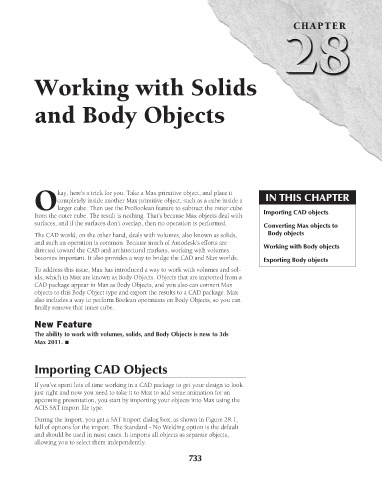Page 781 - Kitab3DsMax
P. 781
Working with Solids
and Body Objects
kay, here’s a trick for you. Take a Max primitive object, and place it CHAPTER
completely inside another Max primitive object, such as a cube inside a IN THIS CHAPTER
Olarger cube. Then use the ProBoolean feature to subtract the inner cube
from the outer cube. The result is nothing. That’s because Max objects deal with Importing CAD objects
surfaces, and if the surfaces don’t overlap, then no operation is performed.
Converting Max objects to
The CAD world, on the other hand, deals with volumes, also known as solids, Body objects
and such an operation is common. Because much of Autodesk’s efforts are
directed toward the CAD and architectural markets, working with volumes Working with Body objects
becomes important. It also provides a way to bridge the CAD and Max worlds. Exporting Body objects
To address this issue, Max has introduced a way to work with volumes and sol-
ids, which in Max are known as Body Objects. Objects that are imported from a
CAD package appear in Max as Body Objects, and you also can convert Max
objects to this Body Object type and export the results to a CAD package. Max
also includes a way to perform Boolean operations on Body Objects, so you can
finally remove that inner cube.
New Feature
The ability to work with volumes, solids, and Body Objects is new to 3ds
Max 2011. n
Importing CAD Objects
If you’ve spent lots of time working in a CAD package to get your design to look
just right and now you need to take it to Max to add some animation for an
upcoming presentation, you start by importing your objects into Max using the
ACIS SAT import file type.
During the import, you get a SAT Import dialog box, as shown in Figure 28.1,
full of options for the import. The Standard - No Welding option is the default
and should be used in most cases. It imports all objects as separate objects,
allowing you to select them independently.
733

